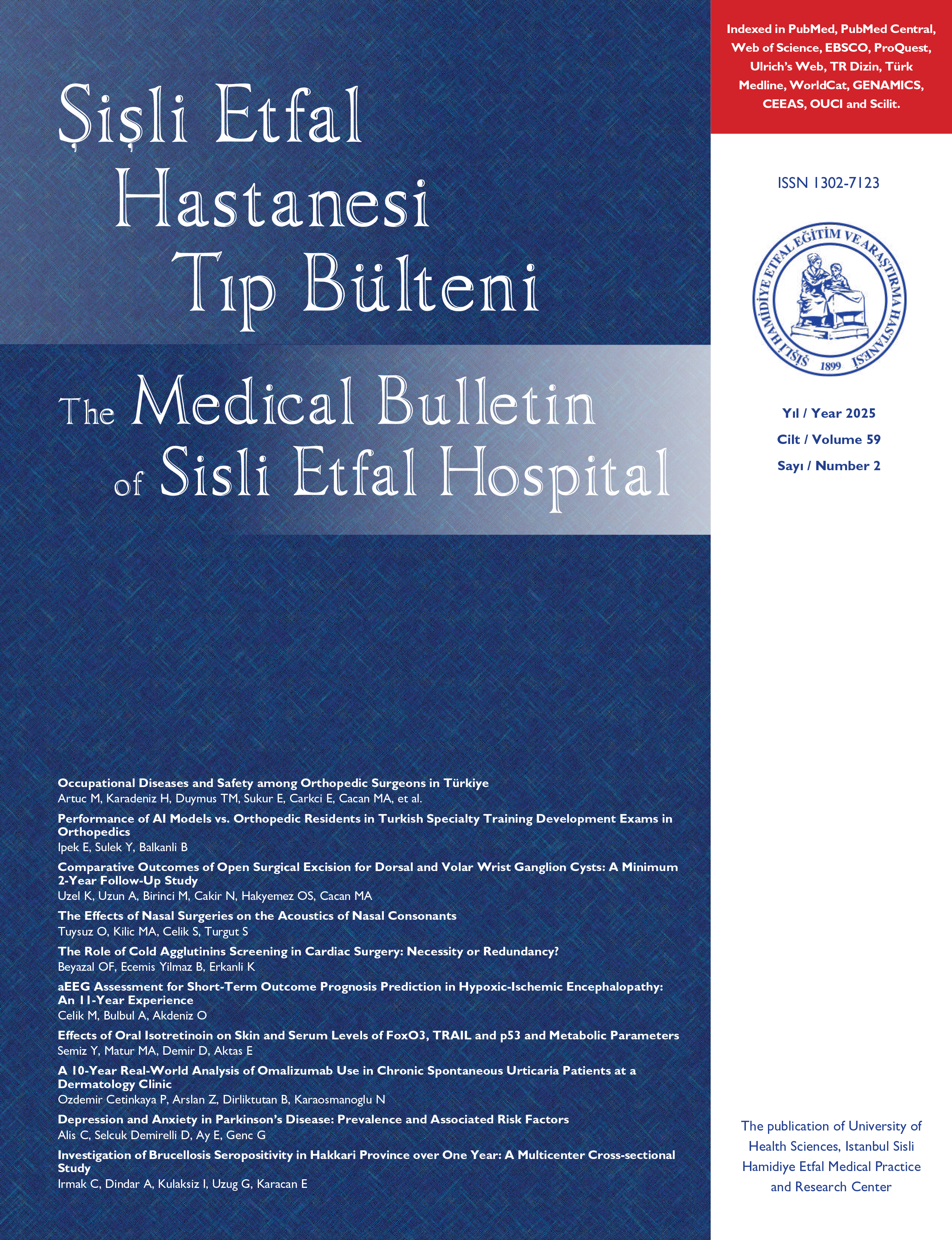
Vertikal alar rezeksiyon (VAR) tekniğinin tip stabilitesi üzerine etkisi; Uzun dönem sonuçları
Sureyya Seneldir1, Tolga Kirgezen2, Arzu Yasemin Korkut31Süreyya Şeneldir Kliniği, İstanbul2İstanbul Eğitim ve Araştırma Hastanesi Kulak Burun Boğaz Bölümü; İstanbul
3İstanbul Şişli Hamidiye Etfal Eğitim ve Araştırma Hastanesi Kulak Burun Boğaz Kliniği; İstanbul
Amaç: Burun ucunun 3 ana özelliği nazal tip projeksiyonu (NTP), nazal tip rotasyonu (NTR) ve belirginliğidir. Burun estetik ameliyatı, anatomik varyasyonlar, patolojiler ve çok farklı ameliyat teknikleri nedeniyle zordur. İdeal teknik, sadece kısa vadede değil uzun vadede de iyi sonuçlar vermelidir. Rinoplastide vertikal alar rezeksiyon (VAR) tekniğinin uzun dönem sonuçlarını analiz etmek.
Yöntemler: 2001-2017 yılları arasında kıdemli yazar tarafından VAR yönteminin kullanıldığı rinoplasti ameliyatı olan 48 hasta (42 kadın, 6 erkek) çalışmaya dahil edildi. Hastaların ortalama yaşı 35.5 yıl (18-56 yıl) idi. Ameliyat sonrası ortalama takip süresi 86.8 ay (dağılım 25-225 ay) idi. Hastaların ameliyat öncesi, erken ve geç ameliyat sonrası fotoğraflarını inceledik. Yıllara göre NTP ve NTR değişiklikleri objektif olarak değerlendirildi. Hastalar ayrıca son kontrol ziyaretlerinde Rinoplasti Sonuç Değerlendirme anketini doldurdu
Bulgular: Ortalama NTP (Goode Metodu ile) geç postoperatif kontrolde erken dönemde 0.60'tan 0.59'a, erken postoperatif kontrolde ortalama nazofasiyal açı 29.4'ten 28.7'ye değişti. Erken ve geç postoperatif kontrol arasında ortalama nazolabial açı (NLA) 97.3'ten 94.5'e ve Tip rotasyon açısı (TRA) 35.2'den 35.4'e değişti. NTP ve NLA'nın erken ve geç postoperatif ölçümleri arasındaki farklar anlamlıydı (tümü için p<0,001), ancak TRA anlamlı olarak değişmedi (p>0,001).
Sonuç: VAR, nazal tip modifikasyonu için faydalı bir yöntemdir. VAR ile NTP ve NTR'yi, lateral crus ve burnun uzunluğunu kontrol edebiliriz; Bu teknikle kısa vadede olduğu gibi uzun vadede de tatmin edici sonuçlar elde edilir. (SETB-2022-11-239)
Anahtar Kelimeler: vertikal alar rezeksiyon, rinoplasti, burun ucu, burun ucu projeksiyonu, burun ucu rotasyonu, dom divizyon
The Effect of the Vertical Alar Resection (VAR) Technique on Tip Stability; Long-Term Results
Sureyya Seneldir1, Tolga Kirgezen2, Arzu Yasemin Korkut31Süreyya Şeneldir Clinic, Istanbul, Türkiye2Department of Otolaryngology, Istanbul Training and Research Hospital, Istanbul, Türkiye
3Department of Ear Nose Throat, University of Health Sciences Turkiye, Sisli Hamidiye Etfal Training and Research Hospital, Istanbul, Türkiye
Objectives: Main properties of nasal tip are the nasal tip projection (NTP), the nasal tip rotation (NTR), and the definition. Its surgery is difficult due to anatomic variations, pathologies, and various surgery possibilities. The ideal technique must also provide good results in long-term. The aim of the study was to analyze long-term results of vertical alar resection (VAR) technique in rhinoplasty.
Methods: Forty-eight patients who underwent rhinoplasty operations that VAR method was used by senior author between 2001 and 2017 were included into the study (42 women and six men). The mean age of patients was 35.5 years (range 1856 years). Mean post-operative follow-up period was 86.8 months (range 25225 months). We analyzed pre=operative, early, and late post-operative photographs of patients. NTP and NTR changes in years were objectively evaluated. Patients also completed Rhinoplasty Outcome Evaluation questionnaire in their last control visit.
Results: Mean NTP (through Goode Method) was changed from 0.60 in early to 0.59 in late post-operative control, mean nasofacial angle from 29.4 in early to 28.7 in late post-operative control. Mean nasolabial angle (NLA) changed from 97.3 to 94.5 and Tip rotation angle (TRA) from 35.2 to 35.4 between early and late post-operative control. Differences between early and late post-operative measures of NTP and NLA were significant (p<0.001 for all), but TRA did not changed significantly (p>0.001).
Conclusion: VAR is a useful method for modifications of lateral crura and nasal tip. With VAR, we can control NTP and NTR, length of lateral crus and nose; get satisfying and long lasting results.
Keywords: Dome division, nasal tip projection, nasal tip rotation, nasal tip, rhinoplasty, vertical alar resection
Makale Dili: İngilizce



















